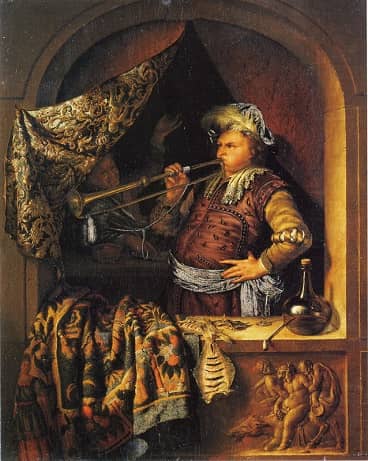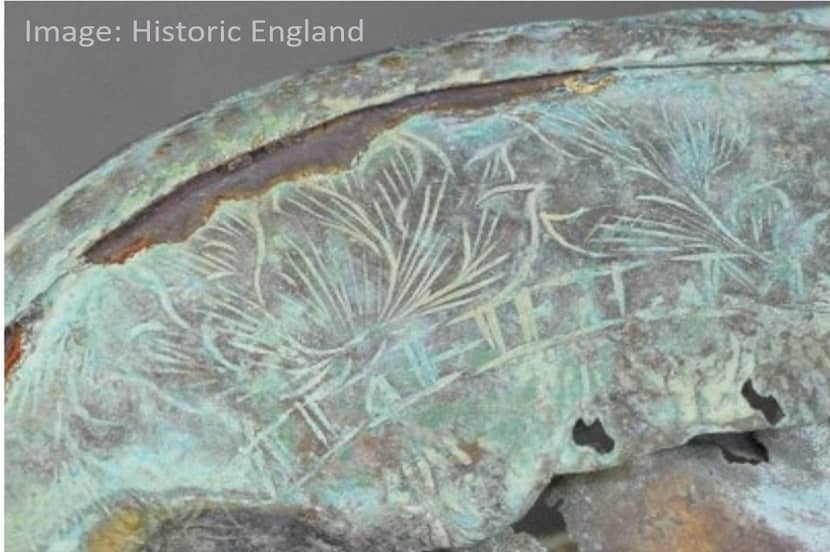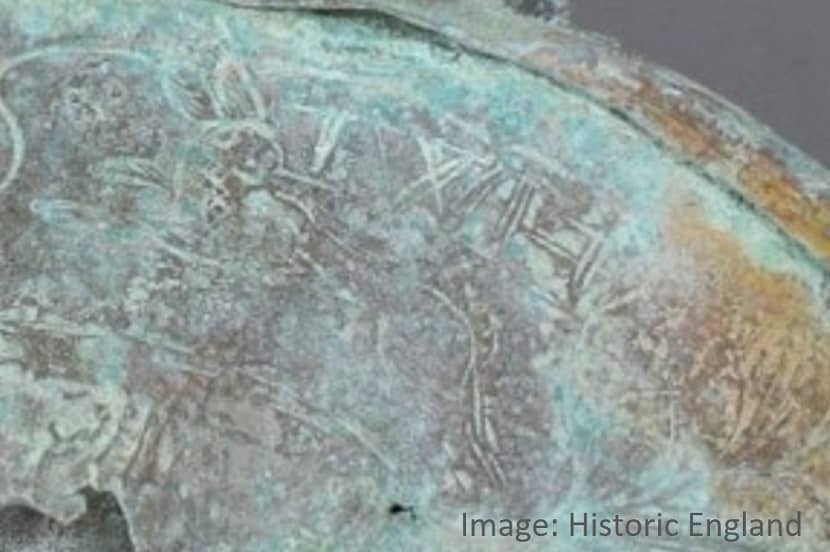In 2017 and 2018, excavations were undertaken on the protected wreck of the Dutch East India Company (VOC) ship Rooswijk. The #Rooswijk1740 project is led and funded by the Cultural Heritage Agency of the Netherlands (RCE) in collaboration with Historic England and MSDS Marine Ltd. Beccy Austin of MSDS Marine writes about one of the remarkable finds discovered during the excavations: a trumpet.
Image: © Historic England
Trumpet bell from the wreck of the Rooswijk
Amongst the thousands of artefacts excavated during the project, which included amongst other objects, ships fixtures and fittings, coins and cargo, were several parts of a trumpet. All of the parts are misshapen and damaged as you might imagine after the wrecking and being on the seabed 20 metres deep for over 270 years, but they are still recognisable trumpet sections.
Why would a trumpet have been on board the Rooswijk?

Image: © Wikimedia Commons / Willem van Mieris, Public domain, via Wikimedia Commons
Trumpeter by Willem van Mieris
Trumpets have been used on board ships for centuries, with evidence of this dating back as far as the 13th Century (Heide, 1996). In the 18th Century it was common to have a trumpeter and drummer on board to indicate the change of watch, to signal mealtimes, communicate with other ships and to sound coming alongside or persons coming on board. They were also required to beat the crew to quarters during battle. Trumpeters were treated as being superior to the drummers who were employed alongside them and carried out similar duties. Trumpeters earned a respectable monthly wage of 16-22 Guilders compared to drummers who earned 8-10 Guilders (Henssen, 2011). The VOC records show that trumpeters were regularly employed on their ships and were on the same level of rank as officers.
A family of famous trumpet makers
Nuremburg was the centre of manufacturing of musical instruments for centuries, It had considerable resources of metal providing and was an ideal location for skilled metalsmiths to work. One of the best renowned master trumpet makers was Johann Wilhelm Haas, whose father and grandfather were watch tower trumpeters. Johann married Ursala Zimmermann, the daughter of a sleigh bell maker, and they had four children. The youngest was Wolf Wilhelm Haas, who took over the family trumpet making business after his father’s death (Smithers, 1965).
There were two main types of trumpets made by the Haas family, ‘simple’ trumpets which were undecorated and usually for military use and ‘ornate’ ones which were decorated and for ceremonial use. The trumpet carried on the Rooswijk is likely to have been an ornate ‘natural trumpet’ similar in shape and style to the one shown in the first photo of this blog and the oil painting by Van Mieris. The sections of trumpet discovered on the wreck of the Rooswijk are decorated with engravings, the bell having the most decorations including tulips and leaves and the makers mark ‘IWH’, making it of the ceremonial style.
Image: © From Smithers, D. (1965) used with permission from the Galpin Society Journal
Drawings showing the different signature Hares engraved by members of the Haas family
Johann Wilhelm Haas engraved the letters ‘IWH’ alongside a picture of a leaping hare to mark his trumpets, as Haas or Hase in German translates as ‘Hare’. His successors used the same initials in the same form but instead with a subtle change to the picture of the hare. Given the date range, we can say that the Rooswijk trumpet was most likely crafted by Wolf Wilhelm Haas as it shows a springing or leaping hare looking over its shoulder. However, it could also have been Wolf’s son Ernst, who also used a running hare looking over its shoulder, but he would have only been 17 or younger when it was made.
The Rooswijk trumpet also has the words ‘WILHELM’, ‘MACHT’ and possibly ‘NURNBERG’ marked on the bell along one of the Haas signature decorations of scallop shells around the bell sleeve. The photos below show a patch which could be a fragment of gold overlay which was sometimes used on ceremonial instruments. The Haas family produced numerous trumpets and horns, and many still exist all over the world as part of museum collections.

Close up of the Rooswijk trumpet bell showing other decorations and ‘WILHELM’ 
Close up of the Rooswijk trumpet bell showing the Hare and the letters ‘IWH’
The Rooswijk Trumpeter
The VOC archives list a trumpeter that once served on the Rooswijk, called Antoonij Tasfier from Utrecht. He was employed by the company in October 1737. The first voyage for Antoonij and his ship was to Batavia (present-day Jakarta) via the Cape of Good Hope. The journey was dangerous and working conditions were often hard. Along with around 85 of his counterparts, it appears that Antoonij died en route in February 1738. After returning to Texel in 1739, the Rooswijk once again set off for Batavia on its second voyage in 1740. It may be that there was not enough time to recruit another skilled trumpeter in this time, and to date it has not been possible to find any further records of trumpeters employed on the Rooswijk. It is possible that Antoonij was the only person to have played the trumpet on this ship. Shortly after leaving Texel in 1740, the Rooswijk was wrecked on the Goodwin Sands during a storm with the loss of all crew.
Image: © Nationaal Archief
Ships Pay Books VOC Number: 1.04.02, Inventory Number: 6058, Folio Number: 34
Bibliography
- 1.04.02 Inventory of the archives of the Dutch East India Company (VOC), 1602-1795 (1811) available from Dutch National Archives.
- Heide, G. J. (1996). The Reconstruction of a 16th Century Italian Trumpet. Historic Brass Society Journal, 42-52.
- Henssen, R. (2011). The Use of Trumpet on Board Ships of the Dutch Easts India Company. International Trumpet Guild Journal, 27.
- Smithers, D. (1965). The Trumpets of JW Haas: A Survey of Four Generations of Nuremburg Brass Instrument Makers. The Galpin Society Journal, Volume 18, 23-41.